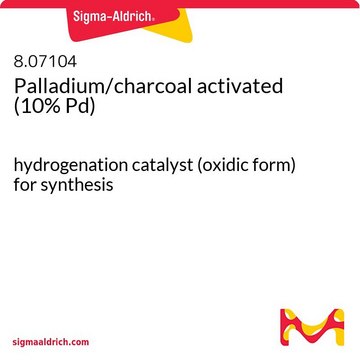227757
Palladium sur charbon
sulfided, extent of labeling: 5 wt. % loading (dry basis), matrix activated carbon, wet support, (wet)
Synonyme(s) :
Pd/C
About This Item
Produits recommandés
Niveau de qualité
Forme
(wet)
Contient
≤50% water
Pertinence de la réaction
core: palladium
reagent type: catalyst
Capacité de réaction
reaction type: Buchwald-Hartwig Cross Coupling Reaction
reaction type: Heck Reaction
reaction type: Hiyama Coupling
reaction type: Negishi Coupling
reaction type: Sonogashira Coupling
reaction type: Stille Coupling
reaction type: Suzuki-Miyaura Coupling
Ampleur du marquage
5 wt. % loading (dry basis)
Poids
Unit weight excludes weight of water
Matrice
activated carbon, wet support
Chaîne SMILES
[Pd]
InChI
1S/Pd
Clé InChI
KDLHZDBZIXYQEI-UHFFFAOYSA-N
Vous recherchez des produits similaires ? Visite Guide de comparaison des produits
Application
- Réaction de Stille
- Réactions d'hydrogénation
- Couplage croisé de Suzuki-Miyaura et réactions de Heck-Mizoroki
- Désoxygénation
- Réactions d'oxydation
- Réactions de couplage
Mention d'avertissement
Danger
Mentions de danger
Conseils de prudence
Classification des risques
Flam. Sol. 1
Code de la classe de stockage
4.1B - Flammable solid hazardous materials
Classe de danger pour l'eau (WGK)
WGK 3
Point d'éclair (°F)
Not applicable
Point d'éclair (°C)
Not applicable
Faites votre choix parmi les versions les plus récentes :
Déjà en possession de ce produit ?
Retrouvez la documentation relative aux produits que vous avez récemment achetés dans la Bibliothèque de documents.
Les clients ont également consulté
Global Trade Item Number
| Référence | GTIN |
|---|---|
| S275808-1EA | |
| 227757-10G | 4061833431696 |
| 227757-50G |
Notre équipe de scientifiques dispose d'une expérience dans tous les secteurs de la recherche, notamment en sciences de la vie, science des matériaux, synthèse chimique, chromatographie, analyse et dans de nombreux autres domaines..
Contacter notre Service technique


![[Pd(OAc)2]3 reagent grade, 98%](/deepweb/assets/sigmaaldrich/product/structures/508/249/99a0ef2c-b77c-4d73-8ed9-0cca05b6b41f/640/99a0ef2c-b77c-4d73-8ed9-0cca05b6b41f.png)

